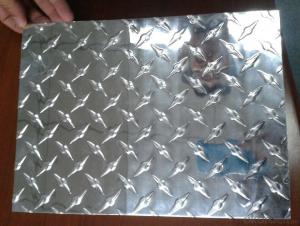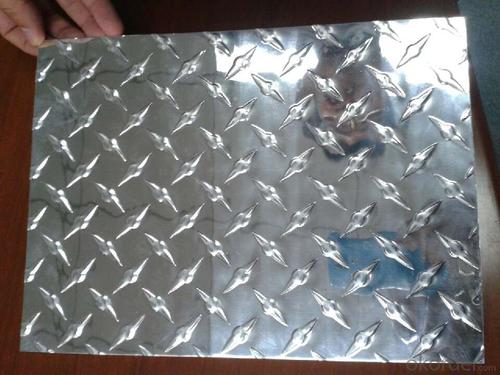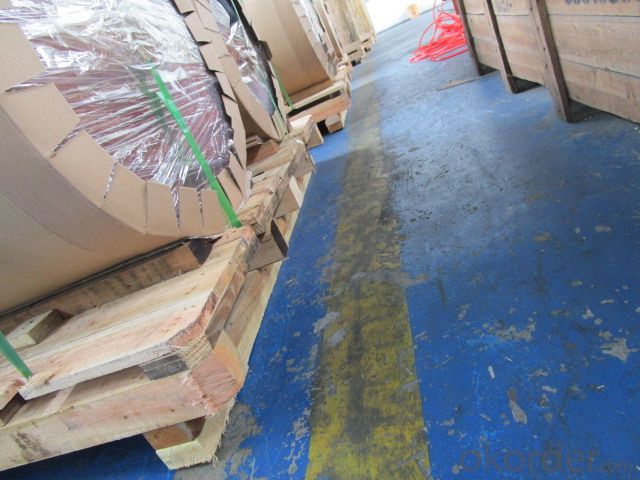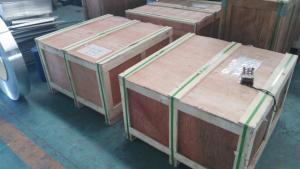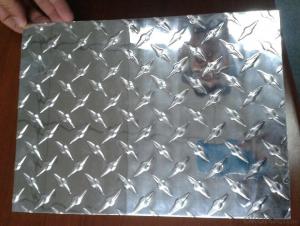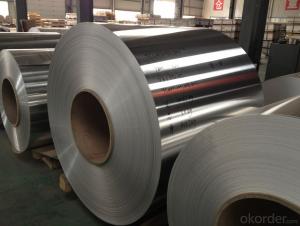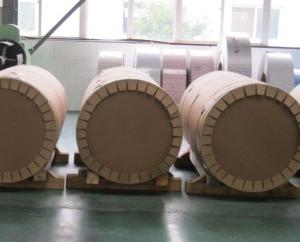Members Mark Aluminum Bake Sheets - Aluminum Drawn Slab with Best Price in Warehouse
- Loading Port:
- Qingdao
- Payment Terms:
- TT OR LC
- Min Order Qty:
- 2 m.t
- Supply Capability:
- 3000 m.t/month
OKorder Service Pledge
OKorder Financial Service
You Might Also Like
Specification
1.Structure of Product Description
aluminum sheet and checkered plates are all widely used in the field of construction field and decoration field, etc.
There are many different grades, such as: 1000 series, 2000 series, 3000 series, 5000 series, 8000 series,etc. The detailed grade are as follows: 1010, 1050,1060,1100, 7075,8011,2024, 3003, 3005, 3105, etc.
The temper is include H14, H22, H24, H44,H112,H114,etc.
2. Main features of the product
a.Competitive price
c. Shortest service.
3. Image.

4. Product detailed sizes:
1000mm*2000mm,500*500,2000*2000mm,1500mm*1500mm,1220mm*2440mm,1219*2438mm, etc.
5. FAQ:
What is the quality standard?
---Usually our standard is GB3880-2006 or others.
What is the width range?
---It is from 400mm to 6000mm, etc.
What is the MOQ for your products yet?
---Normally it is around 11 tons/each size.
How many tons did you export in one year
USA, ENGLISH, SINGAPORE, ETC.
What is your mainly products?
---Normally they are cold rolled and hot rolled and cold drawn aluminum sheet,mirror finish aluminium sheet, aluminum casting coil,caron steel sheet, galvanized steel sheet, color coated steel coils, etc.
- Q: Can aluminum sheet be used for automotive heat shields?
- Indeed, aluminum sheet is a suitable option when it comes to automotive heat shields. The automotive industry favors aluminum due to its impressive thermal conductivity and remarkable heat resistance. By reflecting and dispersing heat away from specific regions, it effectively safeguards delicate components from excessive temperatures. Moreover, aluminum possesses the advantages of being lightweight and resistant to corrosion, rendering it an optimal choice for automotive purposes. It finds widespread utilization in diverse heat shield configurations, encompassing exhaust, engine, and under-carriage heat shields.
- Q: What are the different types of finishes used for decorative aluminum sheet?
- There are several different types of finishes that can be used for decorative aluminum sheet to enhance its appearance and provide added protection. Some of the most common finishes include: 1. Mill finish: This is the standard finish that aluminum sheets have when they come straight from the mill. It has a smooth, shiny appearance but lacks any additional treatments or coatings. 2. Anodized finish: This finish involves an electrochemical process that creates a durable, corrosion-resistant layer on the surface of the aluminum. Anodized finishes can be clear or colored, and they provide a decorative, matte appearance. 3. Brushed finish: Also known as satin finish, this type of finish involves brushing the aluminum sheet with a fine abrasive material to create a pattern of fine lines or scratches. It gives the sheet a textured, non-reflective surface that hides any imperfections. 4. Polished finish: This finish involves polishing the aluminum sheet with a series of abrasive materials to create a smooth, reflective surface. It gives the sheet a shiny, mirror-like appearance and is often used for decorative purposes. 5. Painted finish: Aluminum sheets can also be painted with various types of coatings to provide different colors and finishes. These coatings can be applied through techniques such as powder coating, liquid painting, or coil coating, and they offer both decorative and protective benefits. 6. Embossed finish: In this type of finish, the aluminum sheet is pressed with a pattern or design to create a three-dimensional surface. Embossed finishes can vary in depth and detail, and they add texture and visual interest to the sheet. These are just a few examples of the different types of finishes used for decorative aluminum sheet. Each finish offers its own unique look and benefits, allowing for a wide range of design possibilities.
- Q: What are the different surface finishes for aluminum sheets in the automotive industry?
- Aluminum sheets in the automotive industry have a variety of surface finishes available. These finishes are applied to enhance the appearance, durability, and corrosion resistance of the sheets. Common surface finishes for aluminum sheets in the automotive industry include: 1. Mill Finish: This is the most basic finish for aluminum sheets. It is achieved by extruding the aluminum and passing it through a rolling mill. Mill finish aluminum sheets have a smooth, shiny surface but may have slight imperfections or scratches. 2. Brushed Finish: Also known as satin finish, this texture is created by brushing the surface with abrasive materials. It gives the aluminum a unique grain pattern and a slightly matte appearance. 3. Anodized Finish: Anodizing is an electrochemical process that forms a protective oxide layer on the surface of the aluminum sheet. Anodized aluminum sheets are highly resistant to corrosion and wear. They can be dyed in various colors, offering a decorative and vibrant finish. 4. Polished Finish: Polished aluminum sheets have a reflective, mirror-like surface achieved through mechanical polishing or chemical processes. This finish is often used for decorative purposes, providing a high-end, glossy appearance. 5. Textured Finish: Textured aluminum sheets have a pattern or texture embossed onto the surface. This finish is commonly used for aesthetic purposes, adding visual interest and helping to conceal scratches or imperfections. 6. Painted Finish: Aluminum sheets can be painted to provide extra protection and improve aesthetics. Painted finishes can be customized to match the desired color or design scheme of the automotive industry. This finish offers excellent corrosion resistance and durability. The choice of surface finish for aluminum sheets in the automotive industry depends on the specific application, desired appearance, and functional requirements. Each finish has its own advantages and contributes to the overall performance and visual appeal of automotive parts or components.
- Q: How does the surface roughness of aluminum sheet affect its performance?
- The overall performance of an aluminum sheet can be greatly influenced by its surface roughness. The roughness of the sheet's surface refers to the presence of irregularities, bumps, and texture. Various methods, such as Ra or Rz, can be used to measure these irregularities. One important effect of surface roughness on aluminum sheet performance lies in its ability to bond with other materials. A smoother surface allows for better adhesion, whether through welding, gluing, or painting. In contrast, a rough surface reduces the contact area and weakens the bond. This is particularly crucial in applications where the aluminum sheet is used structurally or in manufacturing processes that require strong adhesion. Surface roughness also affects the sheet's light reflection capabilities. A smoother surface reflects light more uniformly, resulting in a higher level of reflectivity. On the other hand, a rough surface scatters light in different directions, decreasing overall reflectivity. This property is relevant in applications like architectural cladding, where the desired aesthetic appearance depends on consistent light reflection. Additionally, the surface roughness of aluminum sheets can impact their resistance to corrosion. A smoother surface is less susceptible to corrosion as it provides fewer sites for corrosion to start. Conversely, a rougher surface may contain micro crevices or grooves that can trap moisture, salts, or other corrosive substances, speeding up the corrosion process. Maintaining a smooth surface is crucial in applications where corrosion resistance is vital, such as marine environments or outdoor structures. Lastly, surface roughness affects the mechanical properties of the sheet. A rough surface can concentrate stress, making the sheet more prone to fatigue, cracks, or other mechanical failures. Smoother surfaces distribute stress more evenly, enhancing the sheet's overall strength and resistance to deformation. In conclusion, the surface roughness of an aluminum sheet is of utmost importance in determining its performance. It affects adhesion, reflectivity, corrosion resistance, and mechanical properties. Therefore, it is essential to consider and control surface roughness in various applications to ensure optimal performance and longevity of aluminum sheets.
- Q: Are aluminum sheets suitable for food storage containers?
- Yes, aluminum sheets are suitable for food storage containers. Aluminum is a lightweight and versatile metal that is commonly used for food packaging and storage. It is non-toxic, non-reactive, and does not impart any taste or odor to the food stored in it. Aluminum containers are also resistant to corrosion, which helps to keep the food fresh and prevent any contamination. Additionally, aluminum is a good conductor of heat, allowing for efficient cooling or heating of the food. It is also recyclable, making it an eco-friendly choice for food storage containers. Overall, aluminum sheets are a popular and reliable option for storing food safely and effectively.
- Q: How do I join aluminum sheets together?
- To join aluminum sheets together, various methods can be utilized depending on the specific application and desired outcome. Here are several commonly employed techniques: 1. Riveting: Aluminum sheets can be joined by using rivets, which are small metal fasteners. This involves drilling holes in the sheets and then inserting the rivets, which are permanently secured by deforming or compressing them. Riveting is a widely used and durable method for joining aluminum sheets. 2. Welding: Aluminum welding can be accomplished through methods such as gas tungsten arc welding (GTAW), gas metal arc welding (GMAW), or laser welding. These techniques involve melting the aluminum at the joint, allowing it to fuse and create a strong bond upon cooling. Welding necessitates specialized equipment and expertise, but it provides a robust and permanent joining solution. 3. Adhesive bonding: This method employs industrial-grade adhesives specifically designed for bonding aluminum. The adhesive is applied to the surfaces to be joined, and then the sheets are pressed together and allowed to cure. Adhesive bonding results in a clean and aesthetically pleasing joint, although it may not be suitable for high-stress applications. 4. Mechanical fasteners: Another option for joining aluminum sheets is the use of screws, bolts, or nuts. This method entails drilling holes in the sheets and employing fasteners to secure them together. Mechanical fasteners offer a strong and adjustable joint, making disassembly easier if required. Before selecting a joining method, it is important to consider factors such as the strength requirements, appearance, ease of assembly, and disassembly of the application. Additionally, adhering to safety guidelines and seeking professional advice is essential if uncertainty or lack of experience with joining aluminum sheets exists.
- Q: What are the common surface treatments for aluminum sheets used in outdoor applications?
- Aluminum sheets used in outdoor applications can be treated in various ways to improve their durability, resistance to weathering, and appearance. Three common surface treatments include anodizing, powder coating, and PVDF coating. Anodizing is a process that involves immersing the aluminum sheet in an electrolyte solution and applying a current to create a thick oxide layer on its surface. This layer provides excellent protection against corrosion, UV rays, and weathering, making anodized aluminum sheets suitable for outdoor use. Powder coating, on the other hand, is a dry finishing process where a powdered paint is electrostatically applied to the aluminum sheet. The sheet is then heated to melt the powder and form a smooth and durable coating. Powder coating offers exceptional resistance to weathering, scratches, and fading, making it perfect for outdoor applications. It also provides a wide range of color options and gives the sheet a uniform and attractive appearance. Lastly, PVDF coating is a high-performance coating that combines resin with ceramic particles. It is applied as a liquid and cured at high temperatures to form a continuous and protective film on the aluminum sheet. PVDF coatings are known for their exceptional resistance to fading, chalking, and exposure to chemicals, making them suitable for harsh outdoor environments. They also retain their color well, are highly durable, and offer great resistance to UV rays. All of these surface treatments enhance the durability, weather resistance, and aesthetic appeal of aluminum sheets, making them ideal for outdoor applications in industries such as architecture, signage, transportation, and marine. When selecting a surface treatment, it is crucial to consider the specific requirements of the outdoor application, including factors like durability, color options, and resistance to weathering and corrosion.
- Q: This question asks for a list of various types of aluminum sheets that can be found in the market.
- <p>Aluminum sheets available on the market can be categorized based on their thickness, surface finish, and alloy composition. Some common types include: 1) Mill Finish Sheets, which have a natural aluminum finish; 2) Polished Aluminum Sheets, offering a shiny surface; 3) Anodized Aluminum Sheets, which are coated with a protective oxide layer; 4) Checkered Aluminum Sheets, with a slip-resistant pattern; 5) Painted or Coated Aluminum Sheets, with a variety of colors and finishes; 6) Embossed Aluminum Sheets, featuring decorative patterns; 7) Aluminum Foil, which is very thin; and 8) Aluminum Alloy Sheets, such as 6061, 6063, and 2024, each with specific properties for different applications. These types cater to various industries and applications, from construction to automotive and aerospace.</p>
- Q: Are aluminum sheets conductive?
- Yes, aluminum sheets are conductive. Aluminum is a metal and has a high electrical conductivity. This means that electricity can easily flow through aluminum sheets, allowing them to be used in various applications where conductivity is required, such as in electrical wiring, power transmission lines, and electronic devices.
- Q: Can aluminum sheets be anodized for added durability?
- Yes, aluminum sheets can be anodized for added durability. Anodizing is an electrochemical process that creates a protective oxide layer on the surface of aluminum. This layer not only enhances the appearance of the material but also increases its resistance to corrosion, wear, and scratches. Anodizing provides a hard, durable, and long-lasting finish, making it an ideal choice for various applications where durability is crucial, such as in construction, automotive, aerospace, and electronics industries. Additionally, anodized aluminum sheets can be dyed in various colors, further enhancing their aesthetic appeal while maintaining their durability.
Send your message to us
Members Mark Aluminum Bake Sheets - Aluminum Drawn Slab with Best Price in Warehouse
- Loading Port:
- Qingdao
- Payment Terms:
- TT OR LC
- Min Order Qty:
- 2 m.t
- Supply Capability:
- 3000 m.t/month
OKorder Service Pledge
OKorder Financial Service
Similar products
Hot products
Hot Searches
Related keywords
